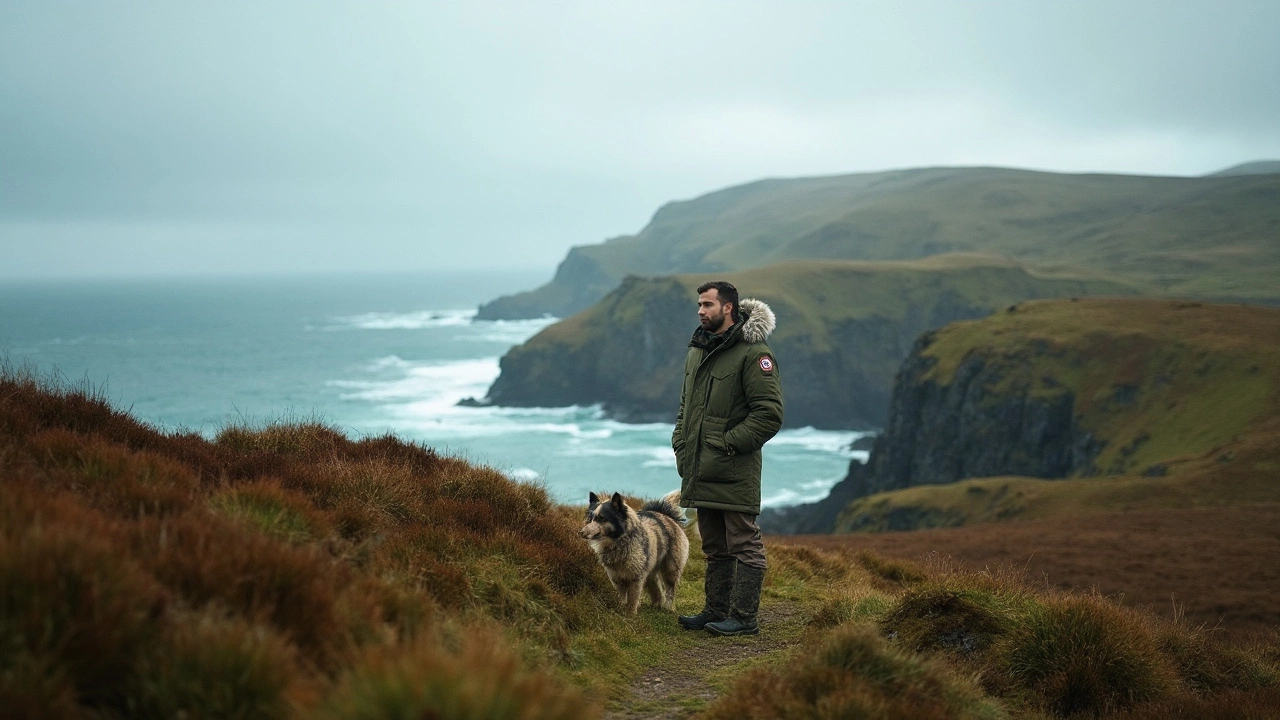If you've ever wandered through Brown Thomas on Grafton Street or scrolled through the Canada Goose site, you’ve probably asked yourself: why is this jacket pricier than a flight to Spain? In Ireland, where winter can be more about sideways rain and biting wind than arctic chills, spotting someone in a Canada Goose parka sometimes makes you do a double-take.
Here’s the thing—you’ll find Canada Goose jackets sitting in the €1,200+ range at Dublin boutiques and online retailers. That’s a chunk more than your average Penneys or even some Barbour coats. Why? In Ireland, much of the cost comes down to import duties, VAT, and shipping from Canada itself. Add to that the higher price for the European market, and suddenly it’s all adding up quickly before you’ve even zipped it up for a stroll along Dun Laoghaire pier.
But there’s more to it than just numbers. People in Ireland, especially in cities like Dublin, Cork, and Galway, aren’t just buying a jacket—they’re buying into decades of branding, craftsmanship, and the idea of weathering a storm in something that’s become a bit of a status piece. Loads of celebs—from sports stars to musicians clocking in Studio 22 during RTÉ’s rainy mornings—have been snapped wearing Canada Goose, which only turns up the hype and pushes that price ever higher.
- Sticker Shock: The Price Tag Explained
- Materials and Craft: What’s Inside That Coat?
- Irish Weather and the Canada Goose Appeal
- Is It Worth the Money in Ireland?
- Alternatives and Smart Shopping Tips for Ireland
Sticker Shock: The Price Tag Explained
When it comes to Canada Goose jackets in Ireland, the sticker shock is real. You’re not imagining things if you feel like the price makes your bank card sweaty. A new Canada Goose parka at a big-name Dublin store, like Brown Thomas or Arnotts, usually starts at about €1,200 and climbs from there. What’s behind those sky-high costs?
One major reason: import duties and VAT. Because these jackets are made in Canada, they hit Irish shelves with an extra layer of customs duty (usually around 12%) and VAT (23%). You’re basically handing over the guts of €250-€350 per jacket just for taxes, and that’s before retail markups even show up.
On top of that, the brand positions itself as luxury outerwear, not just winter kit. Canada Goose puts loads of money into branding and marketing—and the Irish market is no exception. The jackets are distributed through only a few authorized shops here, so prices stay high and discounts are rare, even at big shopping events or after Christmas sales in Cork or Limerick.
Here’s a quick glance at typical prices for popular Canada Goose models in Ireland:
| Jacket Model | Average Price (€) |
|---|---|
| Langford Parka | 1,295 |
| Expedition Parka | 1,395 |
| Chilliwack Bomber | 1,150 |
So when you gasp at the price tag, remember you’re seeing not just the raw cost of making the jacket, but also Irish import rules, hefty taxes, and a sprinkle of exclusivity. Nobody’s getting a Canada Goose on a bargain at Dublin Airport Duty Free or by waiting for a flash sale online.
Materials and Craft: What’s Inside That Coat?
There’s definitely more going on inside a Canada Goose jacket than you’ll find in your typical winter coat. Start with the outer layer—it’s made of Arctic Tech fabric, which is built to take a beating. This stuff is meant to be water-resistant and windproof, which comes in handy for Irish days that feel like horizontal drizzle from Sandycove to Sligo. The stitching is reinforced and the zips don’t mess about, either.
It’s the filling, though, that really sets these jackets apart. We’re talking top-shelf down, mainly from Canadian geese. Wadding from ducks or low-grade birds just doesn’t trap heat the same way. The jackets are packed to a specific “fill power” (usually 625 or higher), which is a fancy way of saying you’ll stay warm when you’re waiting for a train at Pearse Station in January.
Inside, you’ve got proper quilting, and many models come with coyote fur on the hood trim. This isn’t for show—fur actually breaks up icy winds before they hit your face, which is more useful than it sounds if you’ve ever been caught on a blustery Burren hike. All the production still happens in Canada too. None of this outsourcing to save pennies, which means the quality control is brutal. Each jacket comes with a stitched-in label showing exactly where it was made.
If you’re wondering about other bits, here’s a quick breakdown:
- Down insulation: Super lightweight but still traps body heat better than most synthetic fillings.
- Heavy-duty hardware: Metal zippers, sturdy buttons, and fleece-lined pockets that won’t shred after one Irish winter.
- Wind and water resistance: The shell tries hard to keep you dry walking through Limerick city centre on a wet day.
- Long-lasting build: These jackets are made to last for years, not just a season.
| Material | Purpose |
|---|---|
| Arctic Tech Fabric | Resists wind and rain; protects outer layer |
| Canadian Goose Down | Keeps warmth in; lightweight insulation |
| Coyote Fur Trim | Reduces wind chill on the face |
| Reinforced Stitching | Adds durability for years of wear |
No corners are cut, which is why you’re paying north of a grand in Dublin or Cork for one. If you go for a real luxury outerwear piece, you want it to withstand whatever the Irish weather throws at you—and these jackets are genuinely built for that.

Irish Weather and the Canada Goose Appeal
Let’s be real, Ireland isn’t known for blizzards and minus-twenty temperatures—unless you’re heading up Carrauntoohil in late January just for kicks. Most of us are more familiar with storms blowing in off the Atlantic and that damp, cling-to-your-bones cold you feel waiting for the Luas in winter. So why are Canada Goose jackets showing up everywhere, from Trinity’s campus to the Wild Atlantic Way?
The answer is in how these jackets fight off every annoying part of Irish weather. During a typical Dublin winter, you’ll see temperatures hover between 2°C and 8°C, but it’s the wind and rain that do the real damage. With their big down-filled hoods, water-resistant exteriors, and handy pockets, Canada Goose jackets are custom-built to tackle sideways rain at Bray seafront or chilly wind coming up O’Connell Street.
Here’s another key fact: Most other winter coats shrug off a bit of rain, but not all keep you consistently warm in the bone-cold, damp Irish conditions. That’s where the goose down stuffing really shines. Down traps heat like nothing else, which means you’re toasty when you’re queueing at a bus stop, but you won’t feel like you’re wearing a sauna as soon as the bus arrives.
And let’s not forget the culture factor. For a lot of folks in Ireland, wearing Canada Goose is less about sub-zero survival, more about “looking sorted” for city life or weekend trips to Howth. The brand’s logo has started popping up in Instagram photos taken on Grafton Street as much as at ski resorts.
If you’re doubting whether these jackets are even necessary here, listen to what Siobhán O’Toole, a buyer for an Irish outdoor retailer, told Irish Times:
"We see plenty of customers who want a jacket that’ll keep them dry through hours of Irish drizzle while still looking smart. Canada Goose is premium, but a lot of people see it as a long-term investment for our unpredictable weather."
Here’s a snapshot comparing what makes these jackets practical for Irish conditions:
| Feature | How It Helps in Ireland |
|---|---|
| Water-Resistant Shell | Keeps out steady rain from November to March |
| Goose Down Insulation | Traps heat, perfect for cold, damp air near the coast |
| Deep Hood | Shields your head from piercing wind by the River Liffey |
| Multiple Pockets | Room for gloves, Leap card, and your phone, all dry |
| Sleek Design | Works for city commutes and weekend getaways |
If you’re tossing up between your battered parka and a Canada Goose, think about how often you’re freezing on the sideline at Croke Park or battling blustery walks down Henry Street. For lot of Irish buyers, it’s the practical promise—and not just the Arctic badge—that makes the appeal real.
Is It Worth the Money in Ireland?
So, are Canada Goose jackets actually a smart buy for folks living in Ireland? The answer really depends on how you live, what you need, and if you care about that luxury label or just want to stay warm and dry.
Let’s be straight: Ireland doesn’t get minus 25°C as standard, but our wind and rain can make a day in January feel colder than a London winter. Canada Goose jackets are built for harsh Canadian winters, so in theory, they’re more than you need for an average Irish day. But if you’re someone who commutes by bike between Limerick and the University Campus, or you’re out at 6am for a walk along Salthill Prom in Galway, the serious waterproofing and wind-proofing can make a difference. These jackets use high-grade goose down, genuine coyote fur, and rugged fabrics. That means you likely won’t need to buy another coat for years—reliability is a big part of the expense.
The big spin here: you’re paying not only for materials but also for that luxury look. For some in Dublin or Belfast, owning a luxury outerwear piece that’s recognized at a glance is worth the cash. For others, it feels excessive, kind of like popping down to Tesco in Jimmy Choos.
Here’s where the money can make sense:
- You spend lots of time outdoors for work or sport (think GAA coaches, hikers in Connemara, boaters in Howth).
- You want something that lasts years, not just a single winter.
- You care about resale value: second-hand Canada Goose jackets in Ireland can hold up to 60% of their original price on places like Adverts.ie.
- Allergies to cheap synthetics: their use of real down and high-quality materials is way gentler for sensitive skin.
If you just need something for the odd cold snap, there are plenty of cheaper jackets designed for Irish rain at a fraction of the price. Canada Goose is a long-term investment. And don’t forget—because they’re expensive, you’ll want to properly insure that jacket if you’re taking it to music festivals or busy city pubs. Loads of people have reported these coats nicked from cloakrooms and clubs around Temple Bar.
Some Irish retailers offer personal fittings and occasional discounts (especially after Christmas), but prices rarely dip below four figures. If you find an online deal that seems too good to be true, double-check the source—fake Canada Goose sales have caught out plenty of buyers in Ireland, particularly on social media ads.
If you want bullet-proof warmth and see yourself outside more than inside during Irish winters, the price might just work for you. Otherwise, your money might go further on two or three good Irish-made raincoats and a woolly hat from Aran Islands Knitwear.

Alternatives and Smart Shopping Tips for Ireland
So, eyeing that Canada Goose tag but not keen on dropping over a grand? You’re not out of luck. Ireland has plenty of options—some local, some international—that’ll keep you warm (and your wallet not totally empty). You just need to know what to look for and where.
First, check out Irish brands and shops before jumping on pricey imports. Did you know Dubarry of Ireland, best known for their boots, actually make some top-notch jackets? They’re designed for the wet and windy Irish climate, and you can usually catch a sale at outdoor shops like Great Outdoors on Chatham Street or online.
Here’s a look at alternatives often mentioned by Irish outdoor enthusiasts and style-conscious folks alike:
- Patagonia: Their jackets, like the Down Sweater, aren’t cheap, but they cost half as much as Canada Goose. Plus, Patagonia cares about sustainability—and yes, they have official retailers in Ireland.
- The North Face: Widely available at Elverys or Lifestyle Sports, their Thermoball range is insulated, compact, and can handle the typical rain-lashed walk up Ticknock. More city-friendly but still solid for hikes.
- Regatta and Trespass: Regularly stocked in shops like Regatta Great Outdoors (in Liffey Valley and online). Not a status symbol, but these brands do solid, everyday waterproofs for under €100.
- Arc'teryx: This one’s still pricey but often 30-40% cheaper than Canada Goose for similar performance, and you can sometimes pick up last season’s models at a good discount.
Now, onto some actual smart shopping tips tailored for the Irish market:
- Shop during end-of-season sales. Brown Thomas, Arnotts, and Great Outdoors all do winter clear-outs (usually February/March). That’s when the price drops get serious.
- Look for EU-based online shops to avoid heavy customs and VAT. Websites like Snow+Rock, Alpinetrek, and even Amazon UK now ship direct to Ireland, showing you the total price upfront—including duty.
- Try your jackets on in-store—fit matters when it comes to wind-proof and waterproof gear. Dublin’s city centre has proper try-before-you-buy options, avoiding bad surprises in delivery packages.
- Check for brand guarantees. Patagonia and Arc'teryx, for example, offer repair services. It’s less hassle than shipping stuff back to Canada if you need a zip fixed!
The Irish climate is unpredictable, so look for jackets with a good water resistance rating (at least 10,000mm), taped seams, and secure hoods. There are plenty of high-quality expensive jackets out there, but you don’t need to splash out on the big names to stay dry and warm waiting for the bus in Galway or walking along the Cliffs of Moher.
Here’s a quick price comparison based on typical retail prices in Ireland:
| Brand | Typical Price Range (€) | Main Benefit |
|---|---|---|
| Canada Goose | 1,200–1,500 | Luxury, Status, Extreme warmth |
| Patagonia | 250–400 | Eco-friendly, Reliable warmth |
| The North Face | 180–350 | Versatile, Trusted for Irish weather |
| Arc'teryx | 400–900 | Performance, Durability |
| Regatta/Trespass | 60–150 | Budget, Decent weather protection |
Bottom line? Ireland’s weather is no joke, but neither is the choice of alternatives for luxury outerwear. With a bit of research and good timing, you can dodge the hefty price tag and still be sorted for all four seasons in a day.
